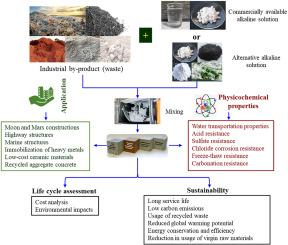地聚合物作为波特兰水泥的可持续替代品:合成、耐久性、应用、环境影响和成本分析
IF 16.3
1区 工程技术
Q1 ENERGY & FUELS
引用次数: 0
摘要
地聚合物正在成为普通硅酸盐水泥(OPC)的可持续替代品,具有减少二氧化碳排放、优异的机械和耐用性能以及利用工业副产品的潜力。虽然许多研究回顾了地聚合物的性质,但对其耐久性、环境影响和成本分析的关注有限。本文探讨了地聚合物的聚合过程和原子结构。全面评述了地聚合物混凝土的耐久性、成本和环境影响,并与OPC混凝土进行了比较。此外,还介绍了商用碱性活化剂替代碱性活化剂的方法。文献表明,地聚合物混凝土的全球变暖潜能值(GWP)比OPC混凝土低16% ~ 90%。然而,地聚合物混凝土有一些小的缺点,包括更高的成本和其他环境影响。结果还表明,与市售活化剂相比,使用替代活化剂可以降低高达61%的全球变暖潜能值,并将地聚合物混凝土的成本降低高达58%。最后,概述了未来的展望,以解决当前的挑战,并促进地聚合物在建筑中的广泛应用。本文章由计算机程序翻译,如有差异,请以英文原文为准。

Geopolymers as a sustainable alternative to Portland cement: Synthesis, durability, applications, environmental impacts, and cost analysis
Geopolymers are emerging as a sustainable alternative to ordinary Portland cement (OPC), offering reduced CO2 emissions, excellent mechanical and durability performance, and the potential to utilize industrial byproducts. Although numerous studies have reviewed the properties of geopolymers, limited attention has been given to their durability, environmental impact, and cost analysis. This paper explores the geopolymerization process and atomic structure of geopolymers. The durability properties, cost, and environmental impacts of geopolymer concrete were comprehensively reviewed and compared with those of OPC concrete. In addition, alternative alkaline activator replacements with commercial alkaline activators have been introduced. The literature indicates that the global warming potential (GWP) of geopolymer concrete is 16 % to 90 % lower than that of OPC concrete. However, geopolymer concrete has some minor drawbacks, including higher costs and other environmental impacts. The results also reveal that using alternative activators can reduce GWP by up to 61 % and the cost of geopolymer concrete by up to 58 % compared to commercially available activators. Finally, future perspectives are outlined to address current challenges and promote the wider adoption of geopolymers in construction.
求助全文
通过发布文献求助,成功后即可免费获取论文全文。
去求助
来源期刊

Renewable and Sustainable Energy Reviews
工程技术-能源与燃料
CiteScore
31.20
自引率
5.70%
发文量
1055
审稿时长
62 days
期刊介绍:
The mission of Renewable and Sustainable Energy Reviews is to disseminate the most compelling and pertinent critical insights in renewable and sustainable energy, fostering collaboration among the research community, private sector, and policy and decision makers. The journal aims to exchange challenges, solutions, innovative concepts, and technologies, contributing to sustainable development, the transition to a low-carbon future, and the attainment of emissions targets outlined by the United Nations Framework Convention on Climate Change.
Renewable and Sustainable Energy Reviews publishes a diverse range of content, including review papers, original research, case studies, and analyses of new technologies, all featuring a substantial review component such as critique, comparison, or analysis. Introducing a distinctive paper type, Expert Insights, the journal presents commissioned mini-reviews authored by field leaders, addressing topics of significant interest. Case studies undergo consideration only if they showcase the work's applicability to other regions or contribute valuable insights to the broader field of renewable and sustainable energy. Notably, a bibliographic or literature review lacking critical analysis is deemed unsuitable for publication.
 求助内容:
求助内容: 应助结果提醒方式:
应助结果提醒方式:


